By Jim Higginbotham
This article originally appears in The Weaponcraft Journal and is reprinted here with permission. The Weaponcraft Journal is available by subscription here.
Did you ever have a project that took decades to complete? Many years ago it struck me that just about all the calculations and experiments that the experts applied to the measurement of recoil of handguns seemed to end up with results that did not reflect what I was seeing in the firing of thousands of rounds each month through those handguns. One day back in the 1980s I picked up a small laser pretty cheap and decided to experiment with lasers as a sighting implement. Even though that experiment was inconclusive at the time, one of the side trails I explored was to compare recoil of different calibers on the same platform . . .
By filming the rise of the laser on a target, which had a grid with one inch spacing, we discovered several surprises. The first is that the human eye does not really see a small dot that travels fast—it perceives that movement. On the range we thought the dot rose just a short way (I thought it rose much higher than my son did which also illustrates that different people have different perceptions of the same movement) but when we played the film back at 1/10th speed it was evident that the dot rose much further than either of us thought it did. In fact it went off the target and we had to build a new one and get closer to find out how far it rose.
This might give some pause to folks who think that they can follow a front sight or the reticle of an optic of some sort in recoil. They are really only perceiving the movement and if they could actually follow that object to its peak travel their eye would be bouncing up and down like a ping pong ball! Actually, it is of small import as the “follow through”, even if it is only perceptive, still ends with the front sight landing back on the target before the next trigger press.
Fast forward to today and we are finally ready to explore this topic. However, I want to point out a few things first. Most important is that this is not exactly science. We will discuss the science associated with recoil briefly but the bottom line is that it does not give us the answers to the practical question of which firearms have recoil characteristics and, more importantly, how do we go about mitigating the effects of recoil in order to be able to deliver effective fire in a self-defense situation?
Before we embark on an exploration of how to manage recoil, which we will address in future editions of this journal, we need to figure out a practical method of measuring recoil. To the neophyte, this would seem to be simple. Well, it turns out it really isn’t that simple.
The time-honored method is to apply long established formula for estimating “free recoil”. This is accomplished by calculating the velocity of the firearm as it reacts from the launching of a projectile from the muzzle. As everyone knows, Newton’s Third Law of Motion is in effect here; “Every action has an equal and opposite reaction”.
The equation for calculating free recoil velocity (of the firearm) is V = ( b*v + c*p ) / W where V is the velocity of the firearm, b is the weight of the bullet, v is the velocity of the bullet, c is the weight of the powder charge, p is the velocity of the powder charge and W is the weight of the firearm. Most people then calculate the Free Recoil Energy based on the standard kinetic energy of the firearm moving at the velocity calculated.
Rather than walk you through using the formula, since we will demonstrate that it is of little practical value, it may be easier to just use one of the online calculators that are available. While most of these are geared toward rifles—the same formula applies to pistols but there are simply more variables involved with handguns that are difficult to place a mathematical value on. One good site for many types of calculators is on a site known as “The Soapbox” which has many different tools and references of interest to the serious shooter. The link to the recoil calculator (as well as an excellent discussion on recoil) is http://kwk.us/recoil.html. Another can be found on the on the excellent Beartooth Bullets site which has several calculators of interest to those who study all forms of ballistics. The recoil calculator is one of several on this page: http://www.beartoothbullets.com/rescources/index.htm.
For the purposes of our discussion I have included a table on just how some of the firearms and loads we used in our recent experiment should show up according to scientific theory. It will become obvious later that there is a huge disconnect between what is predicted mathematically and what actually happens in the real world.
In the calculation I plugged in the loaded weight of the guns, since few people carry empty handguns for self-defense.
As you can see from the table, a .45 Caliber 1911, firing normal pressure 230 grain loads should recoil 31% more than a Glock 17, firing normal pressure 9mm 124 grain loads.
Also, using the standard calculation, a 2″ Airweight .38 firing 158 grain +P ammunition should recoil twice as much as a Ruger LCP .380 firing standard 95 grain ammunition; that same Airweight should recoil 20% more than a 1911 .45.
We found none of those assumptions to be true.
Why is the topic even important? Well, people, especially people who do not shoot a lot, choose handguns based on their perception of several characteristics, such as its size and weight (concealability), its power, how it feels in their hand, safety features, ammunition capacity and their perception of recoil.
Here at AIM we don’t tell folks what handgun, on which their survival will depend, to choose. We do like for people to make an informed decision however. One of the critical topics missing from the above list is reliability. I left it out because I am passing on what we see people ask about or come in with assumptions of their own. They often assume that because a manufacturer will make a product that it will actually work. Well, sometimes they do work and sometimes they don’t—but that is a topic for another day. Here, we are focusing on recoil and its management.
Often a husband will come in to help his wife pick out a self-defense handgun. Or a lady may ask the clerk at a gun store, assuming that he knows a lot about firearms since he works in a gun store. I can tell you from long experience in gun stores that this may or it may not be the case. Quite often in either instance the advice the female who wishes to start carrying will get is to pick a small .380 on the assumption she will carry it in her purse and that she will not want something with a lot of blast, flash and recoil.
The trouble with that is that not only are .380s loud, due to the extremely short barrel, but they actually kick more than most medium sized .45s or even the J-frame .38 Special (depending on the load) and, even more important, they quite often are not reliable in the hands of someone who does not possess more than the normal amount of grip strength or long experience in shooting.
One of our detectives, now retired, wanted to carry a .380 as a backup gun (BUG), made by a world famous maker, which had been issued to him in his former job. Since I run the qualifications and training for our agency I make folks qualify on our regular course with every gun they carry. He was shocked to find that his pistol had 20% stoppages during the course, with ball ammo! He decided that in his case, a J-frame .38 would be a better BUG.
So, back to our topic of recoil; just how does one go about measuring recoil if the standard science does not apply? Well, I’m glad you asked. Mind you, this is not a lecture. It is a discussion. I’ve heard a lot of good ideas and over the decades and I have tried a few of them.
First let us look at the components of recoil. The first is the amount of “shove” to put it in layman’s terms. Remember Newton’s Third Law of Motion. It is indeed still in effect. The more power that comes from the barrel, the more shove that will be applied in the opposite direction. However, the platform has a lot to do with how that “equal and opposite” reaction manifests itself.
Another factor in that “shove” is the time that it takes. This of course is an event that takes place in milliseconds and would be very difficult to measure without high-speed cameras. Most experienced shooters, especially riflemen, tacitly recognize this and often describe the trait as “sharpness”. It is generally recognized that some rifles generate “free recoil”, as calculated above, that actually feels worse than it should. An example is that a .458 Winchester Magnum should kick twice as much as a .338 Winchester magnum in the same weight rifles. Yet everyone that I know that owns both tends to think that they are either too close to call or some even think the .338 has more “kick.” I suspect the paradox can be explained by the fact that the recoil of the .338 is “sharper”, not actually more.
The characteristic however that we are most interested in is muzzle rise. It stands to reason that the higher the muzzle climbs the more difficult it will be to get the sights back on the target for follow up shots. Here too there is more than one thing to consider. The first is how high the muzzle climbs and the second is how fast it climbs. In later articles we will consider how fast we can bring the muzzle back down by applying recoil techniques, but for now let us concentrate on how we can come up with a scale that we can use to assign a value to the amount of muzzle climb.
One is to place the pistol in a machine rest that pivots. The old Ransom Rest was always expensive but it probably was the best way to hold a handgun steady and remove the trigger control issues. It held the gun in a set of firm rubber inserts and there was a pivot point down below the grip frame to allow the pistol to rise in recoil to allow all the energy to be transferred without damage to the gun or the rest. Several authors during the 1960s and 70s tried to get across the comparison of recoil by measuring how high the muzzle rose with the handgun secured in the rest. That does not seem like a bad idea but it overlooks two important factors: first, the pivot point is far below the line of the bore, and second, the human hand does not possess the grip and firmness of the inserts in which the machine rest holds the firearm—one of the reasons the machine rest is good at testing mechanical accuracy but not practical accuracy. As an aside, the other reason is that the rest holds the grip frame and so an autoloader may or may not shoot better in the machine rest. I know several people who shoot autoloaders, at least some autoloaders, better than the machine rest will.
The method we chose to use to explore the topic of recoil was to use the pistol as it would be used, held in the human hand. This first experiment is actually the hardest in that we wanted to measure the “raw recoil” without any attempt to fight or control it. In this case we decided to use one shooter so that the human variable would be as consistent as possible. Even though we used an experienced shooter with the directions to hold the handguns in a loose grip and not lean into the gun, it is hard to keep a good man down and occasionally he would say he thought he gripped the gun too firmly and we would scrap that run. At first he canted the gun a little bit and that caused a problem, but only a slight one, which we will correct in future experiments.
We do not claim our method is scientific or extremely precise. We do feel however it is a practical representation and worthy of consideration when trying to understand how to control a handgun, or as in this article, to compare one handgun to another in regards to recoil.
If you are interested in the details, we set up a target that was five feet high (the pistol was aimed at the bottom of the target) with horizontal bars every six inches so that we could track the dot when we played the film back. We filmed not only the laser dot on the target but the shooters arm and the handgun from the side and we attempted to coordinate the playback, with some success we think.
I made a mistake concerning the target. I chose to go with buff colored cardboard because I feared that white would cause a lot of glare in the film. This was a bad choice. Brown has red as one of its color components and it “absorbs” the laser, making it harder to see. Next time we will use a plastic white target that will reflect the laser better.
Another problem is that, due to the decision to start by shooting with one hand with a loose firing grip, is that a five foot target was not tall enough. Several handguns had so much recoil that the dot went right off the top and our only gauge of how high was that we had a shade canopy and sometimes the dot would be seen to travel up the canvas. I would estimate some of them would have needed a target that was 9-10 feet high! Considering we were shooting at a distance of three yards that is pretty significant. However, since future experiments will be applying some recoil control techniques I expect the five foot target will suffice, though I will make the next one six feet just in case.
One of our checks was to put a box at the bottom of the target and assume that if the bullet did not strike the box that something was amiss and we would strike that shot from the record. As it turned out our shooter was most excellent and the only rounds outside the box were from one in which the laser did not fit the gun well and the bullets hit well above the laser (but in a predictable and consistent manner).
We used a postal scale to weigh the pistols fully loaded and then adjusted them based on the weight of the laser—we used different lasers based on the pistol design but all were pretty light.
We experienced a few problems with a couple of the revolvers since our laser was not overly rigid in its mount. We finally did get a measurement with the use of some gaffer’s tape to keep the laser from flying off in recoil or pivoting on its adjustable mount. Fortunately we had a Crimson Trace grip-type laser for the J-frames so we got what we consider very reliable measurements from those (which included a S&W model 640 .357 magnum).
Another glitch occurred with the Ruger LCP .380. It does not have a rail and therefore we had to use the adjustable mount. We were unable to completely secure the laser since we obviously could not run tape around the slide so the figure for the .380 is does not represent the full travel as the laser pivoted down slightly. I made no effort to estimate how much this affected the result but I think it was significant. Bottom line, the .380 recoiled somewhat more than it appears in our charts below.
Interestingly enough, even though a loose grip often contributes to stoppages in autoloaders, the only malfunction of any kind was with a revolver! It was a true “jam” (something that is fairly rare). The stoppage was with a Lapua manufactured, full-powered .357 magnum cartridge. This load pushes the 158 grain JSP bullet at more than 1300 feet per second and in this particular revolver caused the primer to flow back into the firing pin hole, completely locking the gun up. You could not pull the trigger, cock the gun or open the cylinder. The technical term for this, if it happened in a gun fight, is “You gonna die!” That is unless you have a backup gun. Two is one and one is none!
Fortunately we had some Federal JSP ammo on hand that wasn’t quite as hot and worked well in all the revolvers. I should point out that the particular S&W Model 19 we used is one I carried for police work in the mid to late 1970s and that it always was a “fast” gun, which means the cylinder throats and the bore are tight. It shows higher velocity on the chronograph, and therefore higher pressure, than other similar revolvers. It does in fact produce velocity that is higher than any of my 6″ .357 magnums. So do not assume that this particular lot of Lapua ammo is faulty, but it does illustrate how important it is to test your gun with the ammunition you choose to carry.
OK with that out of the way, let us proceed to look at the figures we came by. We won’t include videos of all of the shots but just a couple that might surprise folks and make no mistake, the results surprised those in attendance.
Below is a chart of the rise of the red dot on our target. Note that the target was only 60 inches tall so those that reach 60 on the chart actually went over. Alas we really don’t know any precise way to estimate how far. And, once again, I would admonish you to not read too much precision into this graph or the associated figures. The purpose is to get a sense of how one gun compares to another while being held in the hand, with no particular effort to control the recoil. Things may change significantly as we apply various recoil control techniques.
We included the chart for those really interested in the numbers, to include the fully loaded weight in ounces, the actual velocity of the loads we used (chronographed later—a couple of the guns were not available later and were checked in barrel lengths of the guns used in the test so they are not perfect but they are very close).
Just as a test I included a calculation of the Power Factor (IPSC) to Weight Ratio. Power Factor is related to momentum and if you are really into math you will see that the “Free Recoil” calculators have as a major component the momentum of the load under test. Just as in the calculation we performed at the outset, the “power to weight” ratio did not seem to reflect what actually happens when firing a handgun but it was worth looking at. As Thomas Edison wrote, “There are no failed experiments, sometimes you just learn what does not work.” I would however point out that it does come closer than the calculators and seems to make some sense at least.
It may come as a shock to many that the least amount of muzzle rise came from a 100 year old design and from arguably the most powerful pistol in the test (it depends on how you measure “power” which is a controversial topic we will address elsewhere). Well, that may be true but it was one of our early tests that we should have revisited as the pistol was held at a cant and the dot went off the edge of the chart. However we did try to compensate by adding a few inches—the dot was slowing down as it got to the edge of the target and it reappeared very quickly so we think it only went a couple of inches further. Still, truth in advertising requires us to note that the figure is even less precise than some of the others.
What does stand out from this test, however, is that there are no “easy” guns, at least not that we tested. There may indeed be some out there but they sure were not found to be large service-size polymer 9mms and they certainly were not the .40s or the .357 Magnums, and alas, not even the little .380.
Once again, our goal is not to tell you what to choose. Rather out goal is to inform and allow you to make a decision based on practical reality rather than pure speculation. Take from this what you will and we hope you will visit us again when we move on to testing the various techniques of controlling recoil.
This article originally appears in The Weaponcraft Journal and is reprinted here with permission.


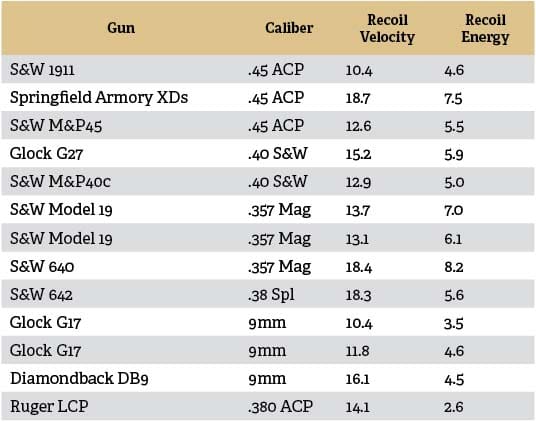
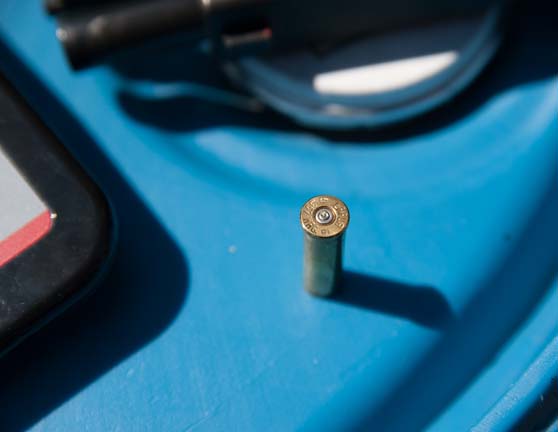

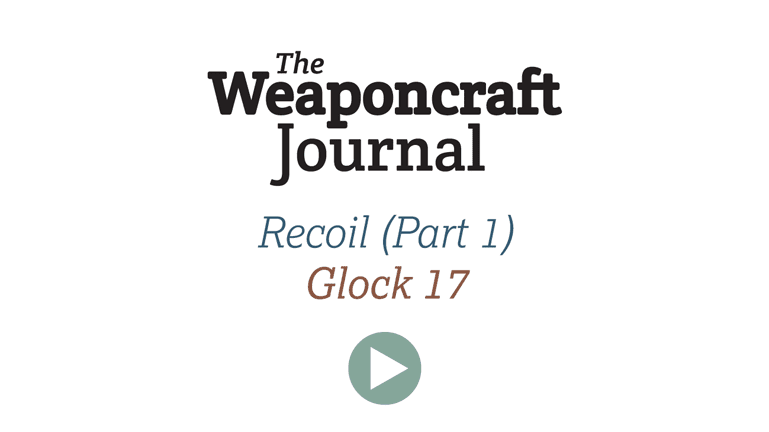
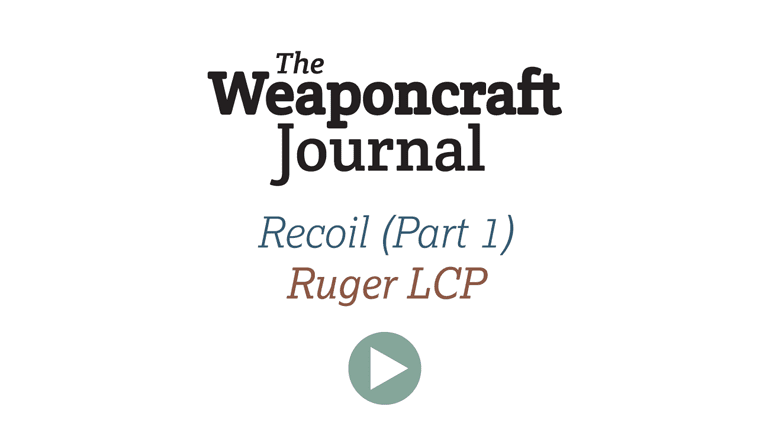
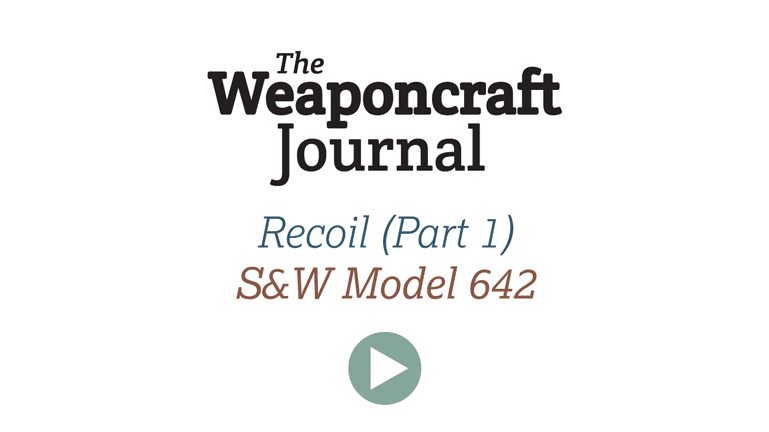
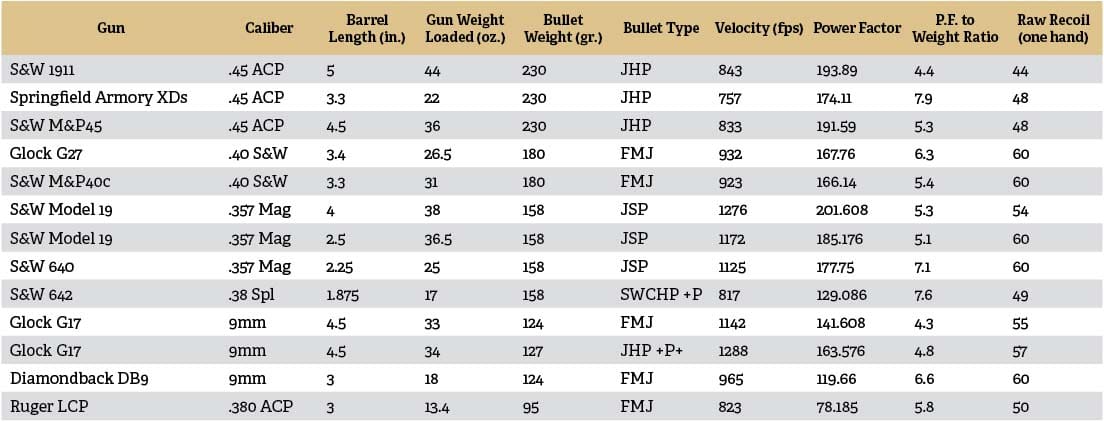

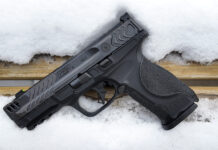


TLDR.
Good for you.
Did you mean to put the whole article on the main page?
What a fantastic article!!
Thanks
Very interesting read, and my hat is off to them for trying to bring some rigor to what will always be a highly subjective area. Thank you!
I haven’t had the time to read the article in detail which I will do this evening. However, come way axking wouldn’t center of gravity also play a bit role in muzzle rise? Everything else equal wouldn’t you expect polymer framed handguns to be “snappier” becuae of the higher CQ? That could explain why the 1911 doesn’t rise as much as expected from the simple calculations. There is so much weight in the grip that it acts to reduce the muzzle rise. 1911s and other steel framed pistols always tend to have more push than flip.
Pistol design ought to have an impact. I have a Kahr that has much less rise than an XD, and as you may recall, Robert was ecstatic abut the felt recoil in his beloved safe queen Caracal. I am pretty sure this has to do with how close the hold is to the centerline of the barrel.
There would seem to be at least a quadruple interplay between center of gravity, bore height over the center of gravity, the effective grip point relative to the center of gravity and the shooter’s wrist.
A larger bore to CG distance would seem to increase recoil by providing the firing of the bullet more leverage while a grip further from the CG would minimize it.
Combined with the effect that the gun can’t fully pivot around it’s CG and the impact of the shooter’s wrist as a pivot point makes for an interesting set of parameters.
I like what they’ve done from the first scan of the article and plan on reading it a little more intensely later.
This is good stuff.
I’ll bet a heavy, steel frame Sig 226 chambered in 9mm would beat them all
Sigs are steel? I thought they were aluminium. But I see what you mean. CZ’s and Beretta 92s would fare equally well.
I believe the P226s were all steel when they first came out but are now have aluminum frames.
The original German made Sig 226s (and 220s) had aluminum frames. Steel frames were a later option and called the 226ST and 220ST. I have a steel X-5 in 9mm and it is a very soft shooter.
I had an old Norinco TT33 clone in 9mm long ago, it was wonderful to shoot. Very little recoil and I have only been able to match my shooting with that 9mm with a 1911 in .45, no other gun I’ve used shoots as well. I wonder how a 9mm 1911 full size would do? It might beat them all?
WonderJay, I have to say you were very lucky. I too, had a Norinco Tokarev clone, known as the 216. Worst shit in creation. Yes, it was a pleasant shooter if memory serves me right, but it was and still is to this day, the most inaccurate handgun I’ve ever had the misfortune to shoot, and I have shot quite a few over the years. A paper plate was completely safe at 7 yards. I ended up having to walk right up to the paper plate to pump a magazine in. And before you suggest it was the operator, bear in mind said operator could hit a Coke can at 50 yards offhand almost every time with a Sig P229. Of course at that time you could buy seven or even eight 216’s for what that P229 cost, too.
The ATF-mandated “safety” quite literally would fall out if overrotated which was not hard at all to do. It had a leaf hammer spring from Hell. I gouged a nice 1/2″ long chunk of flesh out of the heel of my left palm trying to rack the slide on a dropped hammer. You could say it was a feature and not a design flaw, but my hand still hurt like hell.
Sold that damn thing back to the gun shop 2 days later. Thankfully it didn’t cost me too much in the scheme of things. Despite that, with hindsight I wish I’d kept it. Like everything else that’s come and gone. Oh well, story of my life.
Tom
There is the Springfield Range Officer in 9mm to answer that question. The Browning Hi Power is also a good analog and they are really sweet shooters with very benign recoil properties.
…I love real-world data.
I am not surprised about the result with respect to the 1911; I still remember the first time I shot one, a range rental Kimber with a 5″ barrel. The pistol was so smooth and pleasant to shoot that I bought one. I should have bought a full size, though; the four inch barrel shoots a might sharper. Still, it made me a fan of the .45 almost immediately, having shot nothing but .22s and 9mms up to that point.
Agree about the 1911. I find standard .45ACP softer shooting than 9mm or .40cal in any “same model, just different caliber” comparison. I think my reaction is to the combination of muzzle blast and recoil speed in higher pressure calibers.
1911’s are some of the easiest guns to shoot well. Heavy, low pressure round, low bore axis, and a nice single action trigger that minimizes the press issues you get with long double actions. Tough to flinch on a 1/8″ press.
What a great study, with a scientific approach as opposed to seat of the pants feelings.
While it was informative there was a few parts missing. Such as the raw recoil distance numbers converted into angular momentum and then into a unit that makes sense for measuring force. ( Jules, Newton/Meter, ft/lbs) I would also suggest to the author that a measurement or calculation of the rate of change acceleration of the bullet would be required. Due to the fact that on the time scale of recoil, the bullet accelerates quickly when chamber pressure is high and more slowly when it nears the muzzle.
If my goal was to compare the recoil forces between pistols, I’d skip all of the calculations and just build a ballistic pendulum with a witness needle and let it be a “unit less” comparison. This would eliminate a lot of the “noise” and be just a bit more objective.
Oddly enough, Jim references Robin’s ballistic pendulum in another article in this issue, The Quest to Understand Handgun Effectiveness — a very interesting read (but I am biased, as I helped put this journal together and think Jim is a pretty smart guy).
Ya know, I’d actually like to see an article comparing measured recoil of different pistol actions – to see if the different types have any noticeable effect. Does Hi-point’s blowback action increase felt recoil, or is that just a perceived difference? Likewise, does Beretta’s Px4 rotating barrel help alleviate recoil, or is there something more to it?
I just recently picked up a Px4 for a carry piece, and I seem to have a better time keeping that on target than my EAA Witness (both 9mm). Don’t know how much of that is due to the different action or just quality differences overall.
Impulse, impulse, impulse!
excellent discussion! this is a very important distinction and usually described as the difference between a shove and a kick when describing firing a rifle. this is a measure of impulse. there is no way around physics. we shoot a bullet and there is an opposite force to accelerate that bullet. the shorter the amount of time the force has to impart on the shooter, then the more sharply the shooter feels the recoil (higher impulse). energy is the wrong calculation that nearly the entire gun industry uses. conservation of momentum is far more consistent (conservation of momentum is used to calculate collisions).
gun designers handle impulse in the basic design to make a gun function: tilt lock browning style in a semi automatic pistols to keep springs manageable and limit wear on the frame. roller delay lock blowback ala mp5 / g3. gas systems divert a small portion of the gas instead of trying to wrangle all the recoil energy for operation.
caliber choice has some interesting implications. older calibers use a lower pressure, which means the impulse is lower from the beginning. .45 and .38 use much lower pressures than modern calibers and when combined with relatively larger frames usually leads to a “softer” shooting pistol.
gun ergonomics determine how well a gun handles in a given caliber. the closer the grip is to the boreline of the gun, the more mass (conservation of momentum in play) in your forearm to resist the recoil instead of a torque moment about your wrist. a longer slide means the recoil impulse is lower (more time for the recoil). a heavier slide takes more force to accelerate and moves slower also lowering recoil impulse. a longer and heavier slide usually go hand in hand. many modern semi autos use complicated spring designs to provide a non linear recoil to increase recoil time and lower impulse. using a rubber hand grip increases the recoil time marginally and more importantly spreads the impulse to the largest possible hand area (the rubber flows/compresses momentarily to fill the voids when firing).
shoving a .380 in the smallest frame possible means the impulse is HUGE. short and very lightweight slide and lightweight frame means there is very little to slow down the recoil. remember, it is not that the recoil is less (without a compensator) just that the impulse (force over time) is lower.
Great work here. And as someone who shoots a S&W 642 on a regular basis, yes, it recoils like a b1tch. Which is why it’s a terrible gun for new shooters or for use as a target gun.
The 642 is actually a contact and near-contact weapon. As such, its recoil is irrelevant.
I just fired my S&W 637 for the first time today. I was honestly dreading it, first fired 5 rounds of Hornady 110gr +P that I was planning to use as defensive ammo and was surprised how manageable it was. I usually shoot 45 so I guess that may be why, I had a near death grip on it worrying it was gonna jump out. Then I swapped over to some 158gr rn and proceeded to shoot 50 rounds double action only. My trigger finger is pretty tired, that pull is long and difficult to keep smooth, though at least I can feel when its going to go off. Its not the funnest gun to shoot, but it feels good carrying leather IWB and I know I can manage pie plate at 7 yards. Hopefully I don’t need for than 5 rounds.
Excellent!!!! Confirms my experience with Glocks and 1911s.
I recently noticed when shooting my M&P45 that my strong hand thumb makes a huge difference in controlling recoil. Rise was much less when I pressed it on the side of the frame (as if I was riding an invisible safety) compared to just having it point forward.
Someone should do a test comparing the grip sizes and recoil with different size hands. That would be interesting. I prefer the large grip because I can get more of my left hand on the frame, but the medium backstrap allows me to wrap my right hand fingers more around the gun which seems like it would be better for one handed shooting.
Why add the complication of the laser? It is displacing more and faster than the gun itself.
If high speed video camera is available, why not just record the weapon itself from the side? Superimpose a grid in post production and get the data for the gun’s movement itself…both amount of muzzle flip and speed of muzzle movement.
Principle of parsimony in experimental design: never measure indirectly something can be directly measured.
Great article. Please bring more of this kind of stuff to TTAG.
I’m glad to see some numbers that support my position about how I have felt the more mass to the gun plus a high grain cartridge, while probably imparting more actual recoil force to the shooter, is a more manageable and slower “backward” impulse more or less which does not move the sights off the X-axis close to as much as a lighter gun with lower grain rounds and imparts more y-axis torque that give a “jump” that is quicker-thus harder to stabilize on the X with followup shots. These stats are somewhat why I really don’t care for the .40 SW, I feel it has more of the bad qualities of both 9mm and .45ACP (faster y-axis recoil impulse=harder followup shots vs. lower magazine capacity/decreased frequency of lead sent per unit of time/marginal potency difference between modern 9 and .45 carts [yeah, I’ll take the heat for that last but I’m a big boy]). In the end I would much rather carry a quality 9 or 45 with fairly heavy grain cartridges and have the best traits of one aspect with acceptable tradeoffs in their weaknesses rather than a good .40 that is an almost jack-of-most trades but master of none.
Love the gun-geek ballistics crunching and comparing real world use to the raw numbers. I’d like to go even farther and start reloading to tweak stuff even farther. But that scene is kind of a fiduciary event horizon for me these days. Howzabout shotgun felt recoil “lab work” for another article, I actually R most TL;DRs. like this.
Another words, the best gun for any shooter is the one that feels right. There is no perfect gun. There never will be.
What about a G29 with Buffalo Bore loads?
Recoil is composed of two components – muzzle rise and backward push/kick. This research measured only muzzle rise. Although that is very important (muzzle rise has more effect on time to return to on-target), it only tells half of the story. Backward push/kick/sharpness effects how “harsh” a gun feels and how much it seems to ‘beat you up’ as you are shooting multiple rounds through it.
I prefer shooting my Sig P220 (.45, 230 gr., aluminum frame, about 38 ounces loaded) versus my Sig SP2022 (9mm, 115gr., polymer frame, about 36 ounces loaded). The P220 has more recoil, but it is softer (not as sharp) as the SP2022. My arm is less tired after several dozen rounds, and follow-up shots (the 2nd-plus shots in a quick series) are quicker and more accurate.
Do my personal results agree with this study? I don’t know. It just feels like a very important factor, the backward push/kick, has been left out of this study. Maybe it will receive more attention in Part 2 or 3 of the study.
Having read the article in detail I have another question. Since energy is used to move the slide and chambe the next round, shouldn’t an autoloader have less recoil than a revolver for a given power level?
There are very good scientific methods of assessing recoil and felt recoil. The relationship between free recoil energy and felt recoil is tricky to begin with, because depending on grip and gun construction some of it is distributed as “flip” in the y-axis as opposed to straight back on the z-axis. Autoloaders complicate it further because their actions spread the energy over a longer impulse thus reducing the peak.
The state of the art is to attach micro-accelerometers to the “z” and “y” axes of the gun and measure peak acceleration (“g” or m/s^2) during firing.
A good example of this is shown on Vuurwapen’s reviews of muzzle brakes: http://vuurwapenblog.com/2014/01/12/ar-15-muzzle-device-comparison
My question is around the relationship of bullet weight and felt recoil. I know most people will tell you that as you go to heavier bullets you get more recoil, but as a ammo reloader, I understand that as the bullet weight increases you need to lower the powder charge, so as to not exceed the upper pressure limit of the SAMMI spec. Therefore as you increase the bullet weight you drop the powder charge and subsequently the bullet velocity decreases. My question is what would be the effect on felt recoil be if you shot say a 110gn 38 special vs’ 150gn 38 special through he same revolver and adjusted the powder charge to give the same overall pressure?
Bumped into this discussion while researching felt recoil on Google.
I am so happy to find thoughtful, data driven, mathematical/physics based explanations, as well as some of the counterpoints and alternative views. Not rocket science – but Freshman physics, albeit half a century ago (Still got all my teeth and half my mind – or was it vice-versa…)
What a refreshing change from prevalent BS out there; not to devalue practical experience, but to compliment/validate it with the physics behind it.
Thank you gentlemen,you’ve gained a new appreciative follower.
This is a joke, right? They secured their instruments with tape? It would not pass as a junior high school science project, let alone as a freshman English composition.
These articles attempting to correlate physics with feel are great exercises. It’s one of the ways we learn – by looking at the theory and calculations and rubbing our chin when something seems wrong.
I noticed inyour table that for a given caliber, the muzzle rise seems to be higher for a shorter barrel length – that makes sense, because the recoil force is required to lift a longer, heavier barrel, which should mean less movement.
The .45 recoil as measured might be as low as it is because of the redistribution of some of the recoil energy into linear slide movement. That slide is taking some of the force and translating it into a moment going straight back, which delays the timing of the delivery of the recoil force until the slide comes to rest in the rearmost position. Grip angle and grip length could also have an effect.
I have two .44 magnums – an 8 3/8″ barrel model 29 and a Ruger Super Blackhawk. The model 29 is Mag-Na-Ported. The muzzle rise, and the perceived recoil, are moderate. The muzzle rise of the Blackhawk is 90 degrees. But the grip of the Blackhawk allows the gun to rotate upward in your hand, whereas the Smith’s grip is stopped by the web between thumb and forefinger. I find both pleasant to shoot, but for different reasons. And I find that my arm pivots at the elbow, rather than at the wrist, with both of them.
I also have a Walther PPK/S in .380. I find it, oddly enough, not as pleasant to shoot – very counterintuitive. My 1911s show very little muzzle rise, but my grip and wrist position when firing is very different from that used with, say, the Smith.
Finally, the most comfortable gun I have is, of all things, an old aluminum framed .22 made by a company called Whitney – a Wolverine model. It has a very angled grip, and is very natural pointing – almost no muzzle rise whatsoever compared to, for example, my Ruger Standard. The wrist mechanics, I believe, play an enormous role in perceived recoil and controllability. Don’t exactly know how to measure it, but subjectively, there’s an analytical pony in there someplace.
Thanks for the thought-provoking article.
While I’m in the research stages of handgun selection and pretty much a novice I have a question. Doesn’t barrel length play a part in recoil? I would think using the same barrel length would give a more accurate picture.
Interesting topic. I find one great fault with your article. You dissed the 380 based on one gun, a friend of yours that had failure problems. I am a pocket gun enthusiast, shoot often. I have a Beretta Pico that has been totally flawless. Stopped counting rounds at 2500. Bought two more that are the same. And extremely mild to shoot. The Khar CW380 is also so mild a baby could shoot it. My LCP which I have owned 4 are harsh recoil, but have been reliable. (Just not well made compared to the Beretta and Kahr).
Comments are closed.